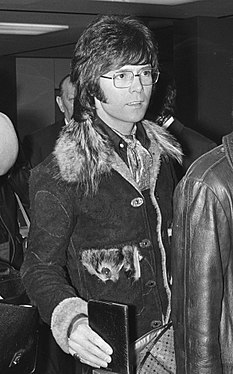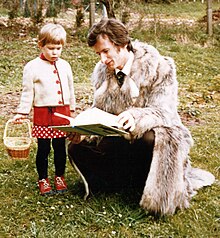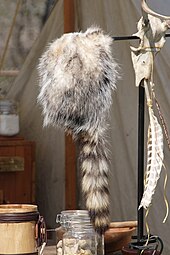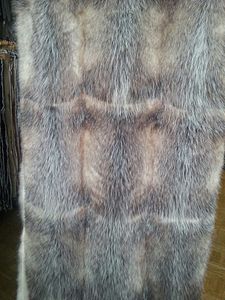Possum fur
In the times of long-haired fur fashion, American opossum fur was the most widely used marsupial for fur purposes and a main item in the fur industry; it is available in large numbers and can be easily refined in imitations of more valuable types of fur .
In the tobacco and fur industry , other types of fur from the marsupial family are traded as possums: the fur of the Australian fox cus or possum, depending on its origin and color, as an Australian, Tasmanian and New Zealand possum (possum) . Conversely, in common parlance in its homeland, the American opossum is also referred to as a possum.
From the American opossum two types of fur processing are suitable:
- the North American opossum ( USA , from southern Canada to the states of the East and Central; exposed in California , Oregon and Washington at the beginning of the 20th century ; then spread to the Pacific coast of California to the mountain range and the Canadian border in the north. Also inhabited it Central America to Costa Rica).
- the South American opossum (from Mexico to the Rio Negro in Argentina).
Other names of the fur of the north opossum were Virginian opossum and Russian marten, the fur of the south opossum Paraguayan opossum and Casaca.
history
In a translation from the year 1581 the use of fur by the Native Americans is mentioned: “In the Neuwen Lands ... and while it is not very warm there, they clothe themselves with Beltzwerk from an animal they call Su . When it is chased by the hunters, it nips its young ones on its back, covers them with a long tail, so flees away. "
The English explorer and settler Captain John Smith (* 1580; † 1631) is said to have been the first to send skins to England. The spelling opossum is said to go back to him, after the Indian name "apasum". In spite of this, fur found its way into the international fur trade relatively late, for example it is not mentioned in the import lists of the Hudson's Bay Company before 1848. But then it quickly caught on; before the First World War , the annual production of the fur industry was around one million pelts.
In the 1920s and 1930s, American college students wore short coats made from both raccoon-coat-collegiate fashion and American opossum as a status symbol. As a motorist's coat and as a faux fur trim , opossum had already competed with raccoons in men's clothing. During this period, opossum was very much in vogue, often dyed, as a trim on textile clothing. Originally only colored in natural, brown or black colors, it turned out to be the ideal basis for imitations of stone marten, pine marten, sable and red fox using the line bleach technique. Appropriate pretreatment, covering the ends of the hair with a wax-paraffin combination, and groaning (enhancing the color of the middle of the fur) made them deceptively similar to the silver fox fur . In Europe, imitations of the skunk skin were particularly popular. The only bleached, yellow-red shimmering skins were called sunburn opossum , a fashion that, however, "hardly lasted for a season". Sheared, the skins were also used as an imitation beaver, they were, like the brown-colored, sheared rabbit skins , under the name "Biberette" in the trade. “Marten opossums” were pelts with mostly short, soft and black awns (not to be confused with “marten-colored opossums”).
The breeding of possums is occasionally mentioned, especially as an experimental animal, but does not seem to have played an essential role for fur purposes. However, the high rate of reproduction with a correspondingly high fur price is offset by the higher food costs of the omnivores compared, for example, to domestic rabbits .
Chasuble studded with possum ( Paul Poiret , 1912, Metropolitan Museum of Art )
Kaiser Wilhelm II and wife Hermine in Persian cloak with possum trimmings and muff (1931)
Old muff from American opossum in muff box
(Fulda, 1st third of the 20th century)Pop singer Cliff Richard in an opossum- studded lamb jacket (1971)
features
| Northern Opossum | South opossum | |
|---|---|---|
| Similarities | Both species are yellowish-white in light to dark shades, occasionally marten-colored with a white background (South American species are sometimes darker to almost black). The crown is dark, the fur sides are yellow-brown to yellowish-white, the throat yellowish-white. The feet are black; the tail is only slightly hairy at the root. | |
| differences | Head almost monochrome light, whitish to yellowish in color. The light, white to yellow tail end always covers more than half of the entire tail length. | Blackish to brownish stripes from nose to eye to ear; The forehead and crown between the ears are dark. The white tail end is less than half the total length of the tail. |
| Sizes | Body about 25 centimeters, tail about 33 centimeters. | Body about 40 centimeters, tail about 30 centimeters. |
The very long hair is silky to fine, coarse to hard. In contrast to the thick, soft and woolly hair of the Australian possum, it is not very thick (sparse); the undercoat often shimmers whitish. The upper hair is 4 to 5 centimeters long, the undercoat 2 to 3 centimeters. Most of the hair is white in the bottom area and black in the tip area, the guide hairs, especially in the fur of older animals, are white throughout. The upper hair has a peculiarity. Even in living animals, the tips of the hairs of the awns tend to split in a fork-like manner over a length of around 2 to 5 millimeters.
- The German fur literature is quite unanimous with the statement of the most important smoking book: "The fur is not very durable, the hair breaks easily". The durability coefficient for American opossum fur is given as 30 to 40 percent. An American textbook, after all from the home of the opossum, comes to a much different assessment. With 70 to 80 percent, compared to the most durable type of fur, it mentions better, even good, durability. When the fur types are divided into the hair fineness classes silky, fine, medium-fine, coarse and hard, the hair of the American opossum is classified as medium-fine.
trade
Come here
- 1. North America
| Size comparison of American opossum pelts | |||||
|---|---|---|---|---|---|
| section | Sizes (in American inches ) |
nature | |||
| XL | L. | M. | S. | ||
| Northern | 42 | 35 | 29 | 26th | full-haired |
| Central | 38 | 32 | 26th | 23 | woolly |
| Western film | 36 | 32 | 26th | 23 | sparsely hairy |
| Southwestern | 36 | 32 | 26th | 23 | kraus ("hairy") |
| Southern | 35 | 30th | 26th | 23 | kraus ("hairy") |
- The fur is only fully developed in late winter and is therefore still very thin in December. It has the best quality in mid-January, whereas the transition period begins at the beginning of February. These skins are then already considered "descendants" or "springs". The hair change is gradual in the northern opossum, it begins on the head and leads to hardly any visible changes; it is probably similar with the southern opossum.
- As the hair is very wavy, it becomes matted at the base of the hair and thus forms a dense and waterproof layer. Both the woolen hair and the lower and middle part of the awns are very wavy. The skins of northern areas are particularly silky and fine, southern areas are coarser (wiry).
- Very large, silky; silvery and light, undercoat white.
- Centrals (Missouri, Arkansas )
- Large; silky, somewhat woolly and thicker hair with less awn density than Northern, but similar overall impression; medium colored, undercoat white. The Arkansas are traded as light centrals.
- Western ( Kansas , Nebraska , California )
- Big, coarser; yellowish awns, often wavy like a corkscrew, less shiny than others after dyeing. Flatter hair and thinner undercoat. Major attack of marten possums.
- Eastern ( Pennsylvania , New York State )
- Big, especially silky; silvery and light, undercoat white; best goods.
- Small, coarse; Undercoat light; dark colored.
- Southwestern (Arkansas, Oklahoma )
- Large, coarse and "hollow" (light undercoat); medium to dark colored; short, soft hair.
- Raw assortment
- Extra large, large, medium, small - The original lots generally contain 40 percent medium, small.
- I, II, III, IV - Types III and IV are mostly sorted out on the raw fur market in St. Louis and treated as irregular types. The original games generally contain 60 percent extra large, large. St. Louis, at the center of the main attack, was the main collection point for the skins, and the ranges were often given designations of origin such as St. Louis Northern etc. as reference.
- The raw fur is usually delivered in the form of a bag (pulled off round, open at the head), with the hair facing inwards.
- 2. Central America
- Stunted hair growth; less suitable for fur purposes.
- 3. South America
- Most of them come from southern Brazil , Uruguay , northern and central Argentina .
- In the original lots there are usually 3 to 4 percent marten-colored skins. They were often sold in special lots at the London auctions. The hair is softer, in general different from the other types.
- The raw skins are often stuck with such a thick layer of fat that the skins heat up if they are stored too densely. The skins intended for longer overseas transport are therefore scraped off beforehand. They are then traded as scraped , as opposed to unscraped.
In the fur trade, a distinction is made between two South American opossum varieties, whereby the opossum-like thick-tailed rat (Lutreolina) does not belong to the opossums zoologically:
- a) South Brazil, Uruguay, Entre Ríos , Córdoba : Large, quite good quality, best areas.
- b) Paraná Delta deposits, Montevideo. Small to medium-sized (zoologically thick-tailed pouch rats, locally Comadrejas colorados).
Both varieties are darker than North American opossums in both the upper hair and undercoat. Marten-colored skins accumulate here in percentage terms. The qualitative difference between the two South American species is so significant that the skins of the two origins cannot be sorted into one another. The color is of little importance for the price, depending on demand, the natural gray skins were a little more expensive, other times the natural black.
A distinction is also made between: Unpelo , monochrome brown skins without black and white guard hair; Doblepelo with black and white awns . The original batches consist of 80 percent of the best quality (Prima) and 20 percent of second quality (Secondary).
The skins are delivered with the hair turned inwards. It is not necessary to scrape the lower layer of fat in South American pelts.
Only around 5 to 10 percent of the pelts delivered have such thick guard hair that they are suitable as trimming material. The remaining pelts do not have even hair height and the awns are often tufted and so sparse that the pelts look "hungry". Good skins are particularly suitable for dyeing. Between the white, only moderately dense undercoat and the more or less protruding silvery awns, there is a layer of dark brown hair, the so-called intermediate cover, which gives the coat its characteristic appearance. Towards the sides of the fur, the fur blanket turns thin and reddish brown. In addition to the good smoke , the skins are particularly valued, in which the awns only protrude slightly over the dark zone, which gives a veil-like effect.
processing
- Semi-finished fur products (tablets) made from opossum
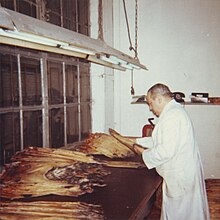
The skins are mainly used in their natural color, but also dyed as an imitation of other types of skin or in the respective fashion colors specified by the textile industry. The colors were skunk, stone marten, tree marten, sable, iltis, virginish iltis, blue fox, silver fox and slate (slate-colored).
Good qualities are processed into trimmings and other small parts. The rest of the goods are used for fur linings , but also for sporty jackets, vests and other items , and with appropriate fashion also for casual coats and fur blankets . At the time of long hair fashion for fur coats and jackets, like many types of fur, opossum pelts were also processed in a considerable amount of exuberance. The fur is cut into very narrow strips that are sewn together the length of the garment. Each fur becomes a strip the length of the coat or jacket, also the sleeve, the fur stole , etc. The processing of the fur largely corresponds to that of raccoon fur and fox fur .
The skins on the neck are very rough and often swirled and therefore require appropriate processing.
As well as the opossum, the waste from the processing fur parts are used in almost all kinds of fur from the fur remains are specialized on the remains of processing fur approaching piece panels manufactured. These semi-finished products are then further processed, preferably to make inner linings. The main place for the recycling of the pieces of fur that accumulates in Europe is Kastoria in Greece and the smaller town of Siatista, which is nearby .
Numbers and facts
Detailed trade figures for North American tobacco products can be found at
- Emil Brass : From the realm of fur . 1st edition, published by the "Neue Pelzwaren-Zeitung and Kürschner-Zeitung", Berlin 1911
- Emil Brass: From the realm of fur . 2nd improved edition, publisher of the "Neue Pelzwaren-Zeitung and Kürschner-Zeitung", Berlin 1925
- Emil Brass: From the Realm of Furs (1911) ( Digitalisat - Internet Archive )
- Milan Novak et al, Ministry of Natural Resources: Wild furbearer management and conservation in North America . Ontario 1987 (English). ISBN 0-7778-6086-4
- Milan Novak et al., Ministry of Natural Resources: Furbearer Harvests in North America, 1600-1984 , Appendix to the above Wild furbearer management and conservation in North America . Ontario 1987 (English). ISBN 0-7729-3564-5
- In 1929 , opossum was one of the four most important fur types in the United States, alongside muskrat , skunks and raccoon .
- An assortment of furriers noted on the Leipzig tobacco market, the Brühl , per fur:
- naturally great 6 to 10 marks
- Marten dyed 11 to 16 marks.
- In 1931 a skunk coat cost an average of 250 marks, a coat made of skunk colored opossums 125 marks. Note: With an assumed opossum fur consumption of 20 to 30 pelts for one coat, this statement can hardly be reconciled with the price of 11 to 16 Marks given for the season of 1928/29.
- Before 1944 , the maximum price for possum pelts was:
- I. variety 9, - RM; II. Variety 6.50 RM; III. Type 4, - RM.
- In 1947 the USA exported the following quantities of raw hides: 786,262 to England, 300,571 to France, 111,413 to Italy and 241,734 to other countries.
- In the 1961/62 and 1962/63 seasons , the official hunting yield of opossums in the USA was 292,628 and 274,628 furs, respectively.
- In 1988 , the incidence of North American opossum pelts was over a million annually; No figures were available for South America, the seizure was estimated “with some probability lower”.
annotation
- ↑ The specified comparative values ( coefficients ) are the result of comparative tests by furriers and tobacco shops with regard to the degree of apparent wear and tear. The figures are not unambiguous; in addition to the subjective observations of durability in practice, there are also influences from fur dressing and fur finishing as well as numerous other factors in each individual case . More precise information could only be determined on a scientific basis. The division was made in steps of 10 percent each. The most durable types of fur according to practical experience were set to 100 percent.
See also
supporting documents
- ↑ a b c Heinrich Dathe , Paul Schöps, with the collaboration of 11 specialist scientists: Pelztieratlas . VEB Gustav Fischer Verlag Jena, 1986, pp. 60-62.
- ^ Fritz Schmidt : The book of the fur and fur animals . Pp. 46-47. Primary source a text translated by Forer 1581.
- ↑ Max Bachrach: Selling Furs Successfully. Prentice Hall, New York 1938; P. 64.
- ↑ a b Fritz Schmidt : The book of the fur animals and pelts . FC Mayer Verlag, Munich 1970, pp. 45-49.
- ↑ a b c d e f Max Bachrach: Fur. A Practical Treatise. Prentice-Hall, Inc., New York 1936. pp. 306, 440-446.
- ↑ Anna Municchi: Ladies in Furs 1900-1940 . Zanfi Editori, Modena 1992, pp. 53-57 (English) ISBN 88-85168-86-8
- ^ Anton Ginzel: American Opossum - a look into the past. In: Pelz-International , Heft 9, Rhenania-Fachverlag, Koblenz September 1986, p. 16
- ↑ Alexander Tuma jun: The practice of the furrier . Published by Julius Springer, Vienna 1928, p. 171.
- ^ A b David G. Kaplan: World of Furs . Fairchield Publications. Inc., New York 1974, pp. 184-185 (English).
- ^ Philipp Manes : The German fur industry and its associations 1900-1940, attempt at a story . Berlin 1941 Volume 4. Copy of the original manuscript, pp. 398–399 ( → table of contents ).
- ↑ a b Friedrich Lorenz: Rauchwarenkunde , 4th edition. Verlag Volk und Wissen, Berlin 1958, p. 31.
- ^ A b c d e Christian Franke / Johanna Kroll: Jury Fränkel ´s Rauchwaren-Handbuch 1988/89 . 10. revised and supplemented new edition, Rifra-Verlag Murrhardt, pp. 235–238.
- ↑ a b Paul Schöps. ua: the opossum . In: Das Pelzgewerbe No. 5, 1966, Hermelin-Verlag Dr. Paul Schöps, Berlin et al., Pp. 207-214.
- ↑ Max Bachrach: Fur. A Practical Treatise. Prentice-Hall, Inc., New York 1949 (6th edition). P. 429 (English).
- ↑ Paul Schöps; H. Brauckhoff, Stuttgart; K. Häse, Leipzig, Richard König , Frankfurt / Main; W. Straube-Daiber, Stuttgart: The durability coefficients of fur skins . In: Das Pelzgewerbe , Volume XV, New Series, 1964, No. 2, Hermelin Verlag Dr. Paul Schöps, Berlin, Frankfurt / Main, Leipzig, Vienna, pp. 56–58.
- ↑ Paul Schöps, Kurt Häse: The fineness of the hair - the fineness classes . In: Das Pelzgewerbe Vol. VI / New Series, 1955 No. 2, Hermelin-Verlag Dr. Paul Schöps, Leipzig, Berlin, Frankfurt am Main, pp. 39–40 (Note: fine (partly silky); medium-fine (partly fine); coarse (medium-fine to coarse)).
- ↑ a b c Alexander Tuma: Pelz-Lexikon. Fur and rough goods. XX. Tape. Verlag Alexander Tuma, Vienna 1950. Keyword “Opossum, amerik.”.
- ↑ a b Kurt Nestler: Tobacco and fur trade . Max Jänecke Verlagbuchhandlung, Leipzig 1929, pp. 69, 106.
- ^ Otto Feistle: Rauchwarenmarkt and Rauchwarenhandel. Verlag W. Kohlhammer, Stuttgart 1931, p. 28. Table of contents .
- ^ Friedrich Malm, August Dietzsch: The art of the furrier. Fachbuchverlag Leipzig 1951, p. 51.





